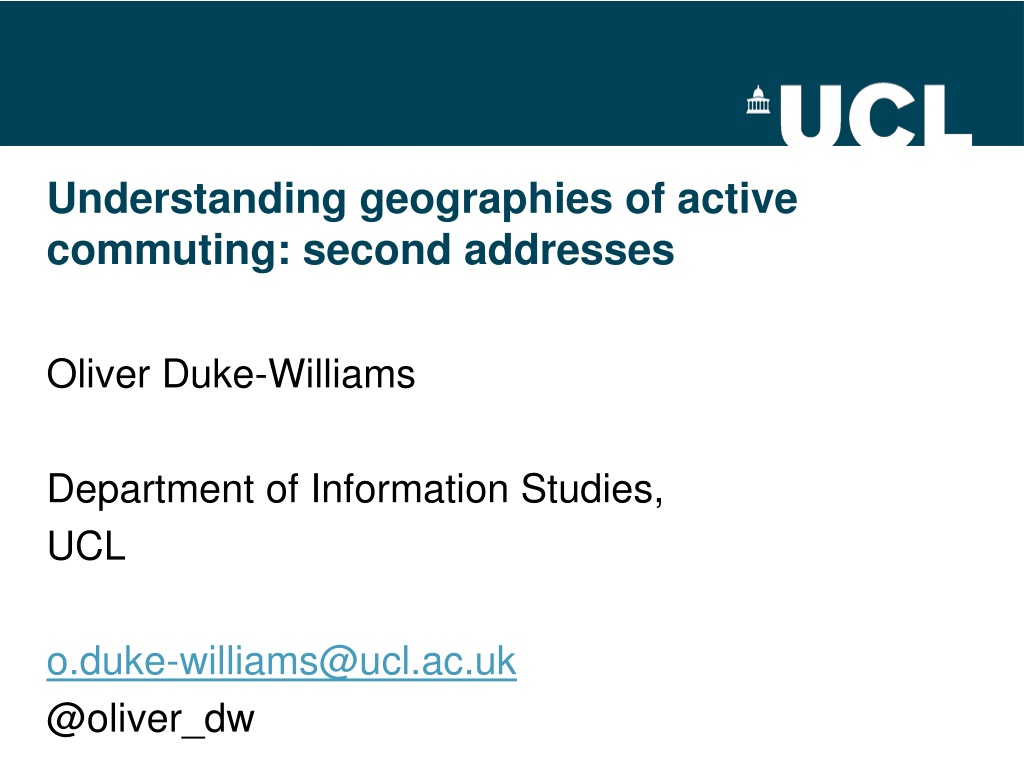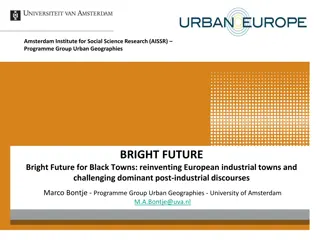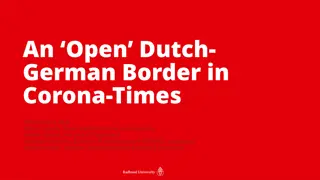Exploring Geographies of Active Commuting and Second Residences
This content dives into the complexities of active commuting and second residences, touching on topics such as census support services, flow data analysis, and progression of data sets dating back to 1981. It delves into the significance of second residences on commuting habits, utilizing various data sources and visualizations to provide insights into this aspect of urban geographies.
Download Presentation

Please find below an Image/Link to download the presentation.
The content on the website is provided AS IS for your information and personal use only. It may not be sold, licensed, or shared on other websites without obtaining consent from the author. Download presentation by click this link. If you encounter any issues during the download, it is possible that the publisher has removed the file from their server.
E N D
Presentation Transcript
Understanding geographies of active commuting: second addresses Oliver Duke-Williams Department of Information Studies, UCL o.duke-williams@ucl.ac.uk @oliver_dw
Context UK Census Support Service What do we mean by second residences ? Exploring the geographies of second residences What do they mean for (active) commuting?
Census Support Service Funded 2012-17 Value added service as part of UK Data Service Provides access to Area data Flow data Micro data Boundary data
Flow data Providing access to flow data from 1981-2011 censuses User support and training Front end: http://wicid.ukdataservice.ac.uk/
2011 Census questions and flow data 2011 Census Origin-Destination Statistics (ODS) available in four sets for the UK: Migration tables based to question 21: What was your usual address one year ago were you living 12 months ago? Student tables a subset of migration tables for people who indicated that their address one year ago was a student / school address Workplace tables based on question 40: In your main job, what is the address of your workplace? Second residence tables based on questions 5 and 6: Do you stay at another address for more than 30 days a year? What is that address? Some tables only available for England and Wales
Progression of flow data sets 1981 Special Migration Statistics Special Workplace Statistics 1991 SMS SWS Special Travel Statistics 2001 SMS SWS 2011 Special Student Statistics Special Residence Statistics SMS SWS
Splitting up the data: 2011 Public / Open Security level Safeguarded "OD data" Secure Data sets SMS SRS Spatial level LAD SWS SSS MSOA Ward Attribute detail OA "Flow" (headcount) Multivariate WPZ Univariate
Summary of ODS through visualisation: SMS 404 destinations (UK) Scotland Wales England Northern Ireland Flow = 0 Flow 0 < 10 Flow >= 10 404 origins (UK) Metro counties Greater London 59 origins (outside UK) Source: 2011 Special Migration Statistics
Summarising 2011 SWS: transport modes Tube / light train etc Train Car driver Flow = 0 Flow 0 < 10 Flow >= 10 Source: 2011 Special Workplace Statistics
Second residences vs second homes vs second address etc Various reasons why someone might have a second residence Tenure of second address not generally captured The question is complex and had few if any comparators in other countries' censuses Some countries include alternative addresses for work purposes (e.g. Swiss Census 2010 asked respondents to give the address from which they normally leave to go to work (or, for children, to go to school)).
Second residence data Multiple locations and relationships identified RF03 RF04 RF01,RF05 Work place RF02 Home Second residence RF01: All persons RF05: Dependent children RF02,03,04: Workers
Second residence: RF05 Dependent children second res. parent or guardian Total persons, all flows: 386,333 Largest flows (all within same LAD) Area Flow E41000291 Leeds 3,886 E41000052 Cornwall 3,792 E41000275 Sheffield 3,245 E41000281 Birmingham 3,107 E41000047 County Durham 3028 Within LAD: Between LADs: 20,308 cases; 150k persons 346 cases; 235k persons Source: 2011 Special Residence Statistics
Second residence: RF03 Usual residence by place of work Total persons, all flows: 302,467 (inc. overseas) Area (within LAD) Flow Area (between LADs) Flow Wiltshire 1,345 Kensington & Chelsea to City & Westminster 613 Cornwall & Scilly 1,282 Wiltshire to City & Westminster 371 Birmingham 944 Wandsworth to City & Westminster 361 City & Westminster 930 Camden to City & Westminster 346 Scottish Borders 926 Lambeth to City & Westminster 294 Total (n=346) 52,355 Total (n=49,625) 159,688 Source: 2011 Special Residence Statistics
Persons with second address, by region, England and Wales 2011 Persons with second address per 1000 residents 9.9 10.8 10.8 11.4 10.5 13.4 27.2 17.4 13.4 9.6 14.6 All persons with second address 25,726 76,412 57,045 51,795 58,940 78,395 222,025 150,252 70,740 29,484 820,814 Source: 2011 Special Residence Statistics Region North East North West Yorkshire East Midlands West Midlands East of England London South East South West Wales England and Wales Population 2,596,886 7,052,177 5,283,733 4,533,222 5,601,847 5,846,965 8,173,941 8,634,750 5,288,935 3,063,456 56,075,912
Proportions of second address reason, by region, England and Wales 2011 Wales Armed Forces address South West Working away from home Holiday home South East London East of England Student: termtime address Student: home address West Midlands East Midlands Yorkshire Another parent or guardian Other North West North East 0% 20% 40% 60% 80% 100% Source: 2011 Special Residence Statistics
Standard view of active commuting: heroic trips Source: 2001 Special Workplace Statistics
A new view of active commuting People are travelling from an address other than their declared usual residence Series of maps of people who have another address Aged 16+, in England and Wales With a second address for work purposes
Modal form of travel to work 1) From usual address London differs from rest of the country Tube most common for most of London Trains in SE London Bus in NE On foot centrally
Modal form of travel to work 2) From second address Story remains same outside London Changes inside London Spatial extent of tube changes slightly Walking hotspot in North Devon
Absolute differences Aggregate change in numbers of persons commuting out of an area Negative (red) values indicate under-reporting if we only look at usual residence data Positive (green) values indicate over-reporting if we only look at usual residence data
Second most common method of transport 1) From usual address On foot most common (but small numbers?) Extended train connections around London
A2 mode2 1) From second address Geography of London changes
Explanatory issues The magnitude of second residence usage is limited on a national level May be more important in local clusters Need to explore local patterns
But! The term second address for work purposes suggests certain arrangements in practice, there are many reasons why people might have such an address
What this means for active commuting? In some areas, previous models of numbers of commuters are wrong Need to explore biases by mode of transport London is main focus for work related second addresses It is also an area with higher proportion of cycle commuters Central London has high proportion of walk-commuters
Access to the data Data from 1981 to 2001 Available as Open Government License data to all Data from 2011 OGL: available to all Safeguarded: available to non-UK academics via a UK Data Service account Secure: probably not available outside UK (?)

























